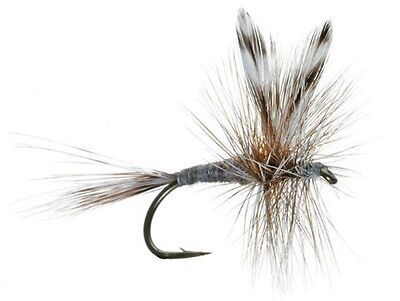The Adams Fly: America’s Favourite
Posted by James on 27th Aug 2025
The Adams Fly: America’s Favourite
“When in doubt, tie on an Adams.”

There is a certain comfort in knowing that if you open your fly box on any river in America, there will almost always be an Adams tucked neatly inside. Some flies are seasonal, others are regional, but the Adams is universal.
Ask a hundred anglers their favourite dry fly, and chances are you will hear the same reply more than any other: “The Adams.”
From a Small Town in Michigan
The story begins in 1922, in Mayfield, Michigan. Leonard Halladay, a local tyer, sat down at his vice and created a fly for his friend, Charles Adams. Leonard was not trying to copy one insect exactly. He wanted a pattern that could pass for many.
Charles tested the fly on the Boardman River and it worked so well that Halladay named it after him. What he did not know at the time was that this modest little creation would become one of the most trusted patterns in the history of fly fishing.
Why It Works Everywhere
The Adams does not belong to any single hatch. Instead, it is what anglers call an impressionistic pattern. To a trout, it might look like a mayfly, a caddis, or even a midge. That ambiguity is its greatest strength.
When trout are rising and you cannot quite tell what they are eating, an Adams in the right size is often the safest bet you can tie on. It has fooled fish in glassy spring creeks, roaring rivers, and mountain lakes alike.
“The Adams has fooled trout for more than a hundred years not by being exact, but by being just convincing enough.”
How Anglers Fish It
Every angler has their ritual with the Adams. Some fish it high and dry with a perfect dead drift, watching it bob along the surface. Others give it the slightest twitch, letting it skate across the water as though a struggling insect is breaking free of the film.
A three to five weight rod, a floating line, and a long leader are the standard. Size the fly to match the mood: a number 12 to tempt eager summer trout in fast water, or a number 20 when autumn browns sip tiny olives from the surface.
It is not just a fly. It is a way of fishing. A declaration of trust that this pattern will connect you to a trout.
Variations That Keep It Alive
- Parachute Adams rides low in the film, visible to both angler and trout
- Female Adams has a small yellow egg sac at the tail, irresistible during mayfly hatches
- Adams Irresistible floats high in broken water thanks to its deer hair body
- Adams Wulff is bold and bushy, made for rougher rivers
- Adams Emerger hangs in the film, perfect for trout fixated on insects halfway hatched
Each version has its place, but they all carry the same spirit of Halladay’s original pattern.
The British Counterpart: The Grey Duster
Here in Britain, our waters have their own legendary all rounder: the Grey Duster. First tied in the early 1900s by R S Austin of Tiverton in Devon, it has stood the test of time just as the Adams has in America.
The Grey Duster is sparse, simple, and incredibly versatile. With its slim grey body and understated hackle, it can suggest a midge, a small olive, or the countless tiny insects that trout rise to on rivers and stillwaters. On chalkstreams in particular, where fish are famously fussy, the Grey Duster has earned its place as a confidence fly.
Where the Adams carries a bushier silhouette, the Grey Duster is leaner and subtler. One was born on American freestones, the other shaped by the delicate waters of Britain. Both are classics that anglers reach for when they are unsure what trout are feeding on.
“The Adams belongs to the States, but the Grey Duster belongs to us.”
Why the Adams Endures
A century after its creation, the Adams is still catching fish and still earning trust. Every guide, every shop, every seasoned angler recommends it. New fly fishers learn to tie it early, veterans keep it close, and trout continue to mistake it for the real thing.
It is not just America’s favourite dry fly. It is a reminder that sometimes the simplest patterns last the longest.
And here in Britain, when we want to make the same declaration of faith, we reach for our own timeless companion: the Grey Duster.
So the next time you are on the water and the rises are mysterious, remember the lessons of both Michigan and Devon: when in doubt, tie on a classic.






